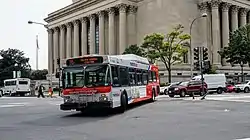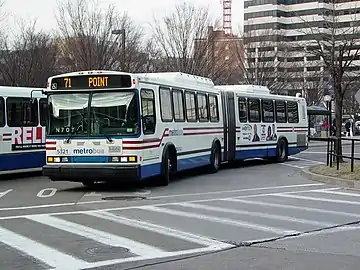Georgia Avenue–7th Street Line
The Georgia Avenue–7th Street Line, designated as Route 70, is a daily bus route that is operated by the Washington Metropolitan Area Transit Authority between Silver Spring station of the Red Line of the Washington Metro and Archives station of the Green and Yellow lines of the Washington Metro. The line operates every 12 minutes during the weekdays, 15 minutes during the weekends, and 20-30 minutes during the late nights. Trips are roughly 60 minutes.
| 70 | |||
|---|---|---|---|
| Georgia Avenue–7th Street Line | |||
 Route 70 at Archives station | |||
| Overview | |||
| System | Metrobus | ||
| Operator | Washington Metropolitan Area Transit Authority | ||
| Garage | Montgomery | ||
| Livery | Local | ||
| Status | In Service | ||
| Began service | 1863 | ||
| Route | |||
| Locale | Northwest, Montgomery County | ||
| Communities served | Silver Spring, Maryland, Shepherd Park, Brightwood, Petworth, Park View, Shaw, Mount Vernon Square, Chinatown, Archives | ||
| Landmarks served | Silver Spring station, Georgia Avenue–Petworth station, Howard University, Shaw–Howard University station, Mount Vernon Square station, Walter E. Washington Convention Center, Gallery Place station, Capital One Arena, Archives station | ||
| Start | Silver Spring station | ||
| Via | Georgia Avenue NW, 7th Street NW | ||
| End | Archives station | ||
| Other routes | 74, 79 | ||
| Service | |||
| Level | Daily | ||
| Frequency | 12 minutes (Weekdays) 15 minutes (Weekends) 15-20 minutes (After 11:00 PM) 30 minutes (After 12:00 AM) | ||
| Operates | 24 Hours | ||
| Transfers | SmarTrip only | ||
| Timetable | Georgia Avenue–7th Street Line | ||
| |||
Current route
Route 70 operates between Silver Spring station and Archives station providing service along the Georgia Avenue and 7th street corridor.[1] The line is one of the most heavily used routes, ranking 5th in ridership as of 2016.[2] It is also one of the few Metrobus routes with dedicated bus lanes.[3] The line is one of the most recognized and popular bus routes.[4]
Route 70 currently operates 24 hours a day out of Montgomery division. It is one of the few routes to use articulated buses on its route due to high passenger volume.[5]
History

Route 70 originally operated under both the Georgia Avenue Line and 7th Street Line. The Georgia Avenue portion was created in 1862 and originally operated by streetcars by the Washington Railway & Electric Company alongside routes 72 and 74.[6] Route 70 operated between Archives and Silver Spring, route 72 operated between Takoma and Downtown DC along Georgia Avenue, and route 74 operated between Soldiers Home in Northwest and Fort McNair.
On October 18, 1888, the day after the Eckington and Soldier's Home began operation, Congress authorized the Brightwood Railway to electrify the Metropolitan's streetcar line on Seventh Street Extended NW or Brightwood Avenue NW (now known as Georgia Avenue NW) and to extend it to the District boundary at Silver Spring. In 1890 they bought the former Boundary and Silver Spring line from the Metropolitan, but continued to operate it as a horse line. In 1892 it was ordered by Congress to switch to overhead electrical power and complete the line.[7][8] The next year, the streetcar tracks reached Takoma Park via a spur along Butternut Street NW to 4th Street NW.[9] In 1898, the Brightwood was ordered to switch to underground electric power on pain of having its charter revoked.[10]
Route 70 was later electrified in 1890, followed by route 72 in 1892, and route 74 in 1893.[6]
The 7th Street section was operated by the Capital Traction Company when it was created in 1873. It originally operated between Archives and Half and O Street in Southwest DC. That line was electrified in 1898.[6]
Later years
When the Capital Traction Company and the Washington Railway & Electric Company merged, forming the Capital Transit Company in 1933, the Georgia Avenue and 7th Street Lines were merged into one route operated under route 70 between Silver Spring and Half and O Streets.[6] Routes 72 and 74 were not affected by the changes.
In 1956, DC Transit acquired the Capital Transit Company and routes 70, 72, and 74 were acquired by them. This also meant the end of streetcars beginning in 1958. Routes 70, 72 and 74 were converted into buses on January 3, 1960 when the Southern Division (Maine Avenue) Car Barn was closed.[11]
Routes 70, 72, and 74 were later acquired by WMATA to run under Metrobus when DC Transit was acquired by WMATA on January 4, 1973.[6][12]
Following the changes, route 72 was discontinued and replaced by routes 50, 52, and 54 while 74 was also discontinued and replaced by route 60.[6] A new route 71 was later introduced to operate alongside the 70 during the weekday peak hours between Silver Spring and Buzzard Point via the 70's routing except operating along 2nd Street, V Street, 1st Street, and T street. A new route 73 was also introduced as the Brightwood-Petworth Line to operate alongside the 70 and 71.
1978 changes

In 1978, route 70 was rerouted to serve the newly opened Silver Spring station connecting riders to the Red Line.
2000 changes
On June 25, 2000, route 73 was eliminated and replaced by routes 70 and 71 as route 73 overlapped both routes.[13]
Proposed restructuring
In 2010, WMATA proposed to shorten routes 70 and 71 to Archives station in order to improve reliability and improve on time performance. All route 70 and 71 service past Archives station to Half and O streets and Buzzard Point would be eliminated. Route P6 would be rerouted from M Street SW via Delaware Avenue, Canal Street, P Street, and 4th Street back to M Street to replace Route 70 and via Delaware Avenue, Canal Street, 2nd Street, V Street, Half Street, S Street, 1st Street, P Street, and 4th Street back to M Street to replace route 71.[14]
A year later, WMATA proposed to end route 70 at Archives station and eliminate all route 71 service. The length of these routes, and the congested traffic conditions under which they operate, are subject them to delays, bunching, and overall poor reliability according to WMATA. Service past Archives station to Half and O streets would be replaced by a new route 74 which will operate on weekdays between Chinatown and Buzzard Point during the weekday peak-hours and between Chinatown and Fort McNair during the off-peak hours. During the weekday evenings and all day weekends, route V8 would be extended to Gallery Place station via Fort McNair.
At the time of the proposals, route 70 operated daily between Silver Spring station and Half and O Street with late night trips ending at Archives station while route 71 only operated during the weekday peak hours while serving Buzzard Point.[15]
2011 changes
On September 25, 2011, route 71 was discontinued and all route 70 trips were shortened to Archives station terminating along Constitution Avenue. Service past Constitution Avenue to Half and O Street/Buzzard Point was discontinued on route 70 with a new route 74 operating between Walter E. Washington Convention Center and Half and O Street while running the Buzzard Point loop during the weekday peak hours.[16][17] The new 74 replaced the 70 and 71 to Half and O Street while also replacing the DC Circulator Convention Center-Southwest Waterfront route.[18][19]
2015 changes
When the Paul S. Sarbanes Transit Center at Silver Spring station opened, route 70 was rerouted from its terminus along Wayne Avenue to the new transit center. Route 70 were assigned to Bus Bay 220 on level 2.[20][21]
References
- Reed, Dan (28 August 2017). "What DC's Most Popular Route Can Tell Us About Our City". Washingtonian. Retrieved 27 June 2020.
- Rowl, DW. "This map shows where the most bus riders live and how close they are to Metro". Greater Greater Washington. Retrieved 22 April 2020.
- Sturdivant, Christina. "DDOT Enforces Dedicated Bus Lanes On Georgia Avenue". DCist. Retrieved 6 May 2020.
- Reed, Dan (28 August 2017). "What DC's Most Popular Route Can Tell Us About Our City". Washingtonian. Retrieved 5 August 2020.
- "New 60-foot bus debut on major corridors | WMATA". www.wmata.com. Retrieved 27 June 2020.
- "WASHINGTON DC TRANSIT ROUTES". www.chicagorailfan.com. Retrieved 27 June 2020.
- States, United; Board Of Commissioners, District of Columbia (1896). Laws Relating to Street-railway Franchises in the District of Columbia. Washington, D.C.: United States, District of Columbia Board of Commissioners.
- Kraft, Brian (November 2003). "Petworth". DCNorth. Retrieved 2007-01-24.
- "Takoma Park Historic District". Archived from the original on 2007-09-29. Retrieved 2007-02-15.
- March, Charles E. (August 1934). "The Local Transportation Problem in the District of Columbia". The Journal of Land and Public Utilities Economics. University of Wisconsin Press. 10 (3): 275–290. doi:10.2307/3139173. JSTOR 3139173.
- "Shaw Main Street: Did You Know?". Shaw Main Street, Inc. 2004. Retrieved 2007-01-30.
- "History". Retrieved 5 August 2020.
- "Metrobus service changes effective June 25, 2000 District of Columbia". June 25, 2000. Archived from the original on October 13, 2000. Retrieved August 5, 2020.
- "DISTRICT OF COLUMBIA PROPOSED BUS SERVICE CHANGES FISCAL YEAR 2011" (PDF). Retrieved 5 August 2020.
- "70,71 Georgia Ave.-7th St. Line" (PDF). www.wmata.com. Archived from the original (PDF) on December 3, 2010.
- Thomson, Robert (23 September 2011). "Metrobus changes start Sunday". Washington Post. Retrieved 5 August 2020.
- "Metro to adjust select bus routes in DC, Virginia". www.wmata.com. Archived from the original on September 24, 2011. Retrieved 5 August 2020.
- Fitzgerald, Erin. "Metro launches 74 bus route, ends Southwest Circulator". The Southwester. Retrieved 3 May 2020.
- "DDOT to Implement Changes to Existing Circulator Service". District of Columbia Department of Transportation. Archived from the original on May 3, 2020. Retrieved 5 August 2020.
- Goldchain, Michelle (21 September 2015). "Finally, The Silver Spring Transit Center Makes Its Debut". Curbed DC. Retrieved 5 August 2020.
- "Paul S. Sarbanes Transit Center in Silver Spring". www.wmata.com. Retrieved 5 August 2020.